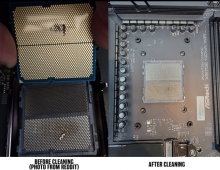
AMD to Employ GDDR5 In Next-Generation ATI Radeon Graphics Solutions
AMD officially announced the first commercial implementation of Graphics Double Data Rate, version 5 (GDDR5) memory in its forthcoming next generation of ATI Radeon graphics card products.
The high-speed, high-bandwidth GDDR5 technology is expected to become the new memory standard in the industry. AMD is working with a number of memory providers, including Samsung, Hynix and Qimonda, to bring GDDR5 to market.
Today's GPU performance is limited by the rate at which data can be moved on and off the graphics chip, which in turn is limited by the memory interface width and die size. The higher data rates supported by GDDR5 - up to 5x that of GDDR3 and 4x that of GDDR4 - enable more bandwidth over a narrower memory interface, which can translate into superior performance delivered from smaller, more cost-effective chips. AMD's internal testing demonstrates 30% lower DRAM memory bus power when comparing GDDR5 to GDDR3. GDDR3 at 2Gbps runs at 2.0V and GDDR5 at 4.0Gbps runs at 1.5V in 3DMark01 Nature test. Specs demonstrate that GDDR5 is capable of up to 12.8Gbps vs. GDDR4's 3.2Gbps and GDDR3's 2.4Gbps.
AMD's senior engineers worked closely with industry standards body JEDEC in developing the new memory technology and defining the GDDR5 spec.
"The days of monolithic mega-chips are gone. Being first to market with GDDR in our next-generation architecture, AMD is able to deliver incredible performance using more cost-effective GPUs," said Rick Bergman, Senior Vice President and General Manager, Graphics Product Group, AMD. "AMD believes that GDDR5 is the optimal way to drive performance gains while being mindful of power consumption. We?re excited about the potential GDDR5 brings to the table for innovative game development and even more exciting game play."
AMD expects that PC graphics will benefit from the increase in memory bandwidth for a variety of intensive applications. PC gamers will have the potential to play at high resolutions and image quality settings, with higher overall gaming performance. PC applications will have the potential to benefit from fast load times, with superior responsiveness and multi-tasking.
In addition to the potential for improved gaming and PC application performance, GDDR5 also holds a number of benefits for stream processing, where GPUs are applied to address complex, massively parallel calculations. Such calculations are prevalent in high-performance computing, financial and academic segments among others. AMD expects that the increased bandwidth of GDDR5 will greatly benefit certain classes of stream computations.
New error detection mechanisms in GDDR5 can also help increase the accuracy of calculations by indentifying errors and re-issuing commands to get valid data.
According to early information from various media reports, the new ATI RV770 GPU will be built upon the 55nm process technology and will have 480 unified shader processors, 32 texture units, a new generation video engine and 256-bit memory interface.
ATI plans to release ATI Radeon HD 4870 1GB GDDR5 and ATI Radeon HD 4850 512MB GDDR3 variations initially at $50 and $250 price points. A more powerful ATI Radeon HD 4870 X2 is set to be available later this year.
Today's GPU performance is limited by the rate at which data can be moved on and off the graphics chip, which in turn is limited by the memory interface width and die size. The higher data rates supported by GDDR5 - up to 5x that of GDDR3 and 4x that of GDDR4 - enable more bandwidth over a narrower memory interface, which can translate into superior performance delivered from smaller, more cost-effective chips. AMD's internal testing demonstrates 30% lower DRAM memory bus power when comparing GDDR5 to GDDR3. GDDR3 at 2Gbps runs at 2.0V and GDDR5 at 4.0Gbps runs at 1.5V in 3DMark01 Nature test. Specs demonstrate that GDDR5 is capable of up to 12.8Gbps vs. GDDR4's 3.2Gbps and GDDR3's 2.4Gbps.
AMD's senior engineers worked closely with industry standards body JEDEC in developing the new memory technology and defining the GDDR5 spec.
"The days of monolithic mega-chips are gone. Being first to market with GDDR in our next-generation architecture, AMD is able to deliver incredible performance using more cost-effective GPUs," said Rick Bergman, Senior Vice President and General Manager, Graphics Product Group, AMD. "AMD believes that GDDR5 is the optimal way to drive performance gains while being mindful of power consumption. We?re excited about the potential GDDR5 brings to the table for innovative game development and even more exciting game play."
AMD expects that PC graphics will benefit from the increase in memory bandwidth for a variety of intensive applications. PC gamers will have the potential to play at high resolutions and image quality settings, with higher overall gaming performance. PC applications will have the potential to benefit from fast load times, with superior responsiveness and multi-tasking.
In addition to the potential for improved gaming and PC application performance, GDDR5 also holds a number of benefits for stream processing, where GPUs are applied to address complex, massively parallel calculations. Such calculations are prevalent in high-performance computing, financial and academic segments among others. AMD expects that the increased bandwidth of GDDR5 will greatly benefit certain classes of stream computations.
New error detection mechanisms in GDDR5 can also help increase the accuracy of calculations by indentifying errors and re-issuing commands to get valid data.
According to early information from various media reports, the new ATI RV770 GPU will be built upon the 55nm process technology and will have 480 unified shader processors, 32 texture units, a new generation video engine and 256-bit memory interface.
ATI plans to release ATI Radeon HD 4870 1GB GDDR5 and ATI Radeon HD 4850 512MB GDDR3 variations initially at $50 and $250 price points. A more powerful ATI Radeon HD 4870 X2 is set to be available later this year.





















